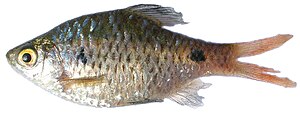Two-point barb
| Two-point barb | ||||||||||||
|---|---|---|---|---|---|---|---|---|---|---|---|---|

Two-point barb ( Pethia ticto ) |
||||||||||||
| Systematics | ||||||||||||
|
||||||||||||
| Scientific name | ||||||||||||
| Pethia ticto | ||||||||||||
| ( Hamilton , 1822) |
The two-point barbel ( Pethia ticto ; old synonym : Puntius ticto , Barbus ticto ) is a freshwater fish from the carp family (Cyprinidae). Their large area of distribution includes the Indian subcontinent , Sri Lanka , Burma ( Irrawaddy and Saluen ) and Thailand (upper Mae Nam Chao Phraya and upper Mekong ). The type epithet ticto was given after a local name ("ticto-sophore").
features
The two-point barb becomes ten centimeters long. Their physique is typical of small South Asian barbels. With increasing age the fish get higher back. Their back is olive gray to grass green, the flanks are silvery, the belly white. The name is given by the small, elongated, transverse dark spot above the pectoral fins and the larger, gold-framed spot above the anal fin end on the tail fin stalk. Outside the spawning season, all fins are colorless to slightly greenish, the pelvic fins and anal fin become reddish during spawning. The males get a fawn-colored belly, the eye becomes blood-red above. The dorsal fin is usually dotted with black at the edge. The sideline is short and only extends over 6 to 12 scales. Barbels are absent.
- Fin formula : dorsal : 3/8; Anal : 2/5.
- Dandruff formula : mLR 23-26, SL 6-12.
Way of life
The two-point barbel lives near the shore in shallow, slowly flowing waters, usually with a muddy bottom. It feeds on crustaceans, insects and plankton and looks for food mainly on the bottom of the water. During reproduction, the female lays a total of around 150 eggs, which are laid in individual portions of around 20 eggs. The larvae hatch after 24 to 30 hours, depending on the water temperature, and swim freely after four to five days.
Systematics
The two-point barbel originally belonged to the genus Puntius and there to the P. conchonius species group named after the magnificent barbel and comprising around 20 closely related species . In 2012 the species group was raised to the genus rank under the name Pethia . According to its large distribution area, the species is varied and there are numerous different color morphs. Recently, some forms that occur in the outskirts of India and that were previously part of Pethia ticto have been described as separate species. These include Pethia muvattupuzhaensis , Pethia nigripinnis and Pethia pookodensis .
literature
- Günther Sterba : Freshwater fish of the world , Weltbild Verlag, Augsburg 1998, ISBN 3-89350-991-7 .
- Axel Zarske: Barbus ticto. In: Claus Schaefer, Torsten Schröer (Hrsg.): The large lexicon of aquaristics. Eugen Ulmer, Stuttgart 2004, ISBN 3-8001-7497-9 , p. 136.
Individual evidence
- ↑ Rohan Pethiyagoda, Madhava Meegaskumbura & Kalana Maduwage: A synopsis of the South Asian fishes referred to Puntius (Pisces: Cyprinidae). Ichthyol. Explor. Freshwaters, Vol. 23, No. 1, pages 69-95, 11 figs., 4 tabs., June 2012, © 2012 by Verlag Dr. Friedrich Pfeil, Munich, Germany - ISSN 0936-9902
- ↑ Knight, JDM, Rema Devi, K., Indra, TJ & Arunachalam, M. (2012): A new species of barb Puntius nigripinnis (Teleostei: Cyprinidae) from southern Western Ghats, India. Journal of Threatened Taxa, 4 (3): 2409-2416.
Web links
- Two-point barbel on Fishbase.org (English)
- Pethia ticto inthe IUCN 2013 Red List of Threatened Species . Posted by: Dahanukar, N., 2010. Retrieved December 17, 2013.